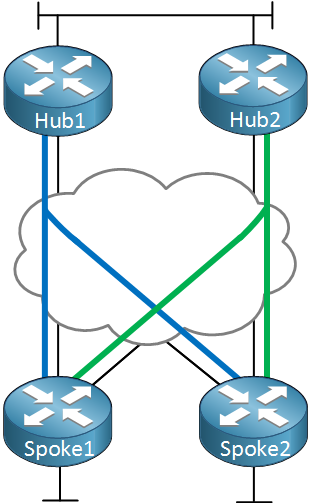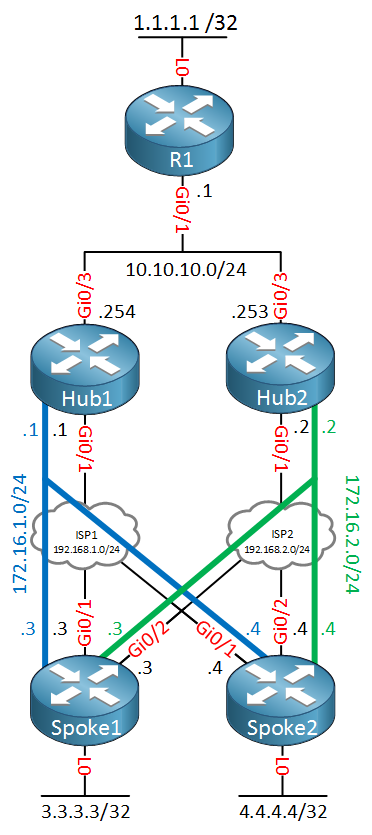Lesson Contents
In previous DMVPN lessons I explained how to configure a small DMVPN network using a hub and two spoke routers. The disadvantage of a single hub router is that it’s a single point of failure. Once your hub router fails, the entire DMVPN network is gone.
To add redundancy to our DMVPN network we need to add another hub router. There are two options for this:
Dual hub – Single Cloud
Dual hub – Dual Cloud
With the single cloud option we use a single DMVPN network but we add a second hub. The spoke routers will use only one multipoint GRE interface where we configure the second hub as a next hop server.
The dual cloud option also has two hubs but we will use two DMVPN networks which means that all spoke routers will get a second multipoint GRE interface.
In this lesson we’ll take a look at the dual hub dual cloud option. This is the best option for DMVPN dual hub. Take a look at the following picture:

Above we have two hub routers and two spoke routers. Each hub router will be connected to a different ISP and we will create two DMVPN networks. The spoke routers will be connected to both DMVPN networks which means they’ll have two multipoint GRE interfaces. The main advantage of using two interfaces is that it’s easy to influence your routing. The only disadvantage is that it takes a bit more time to build this configuration.
Configuration
To demonstrate all of this, we’ll use the following topology:

Above we have the R1 router which is on the main site. Hub1 and hub2 provide access to our main network and are connected to different ISPs. This is not a requirement but for redundancy, it makes sense to use a different ISP for each hub.
The spoke routers are connected to both ISPs and will connect to both DMVPN networks. R1, spoke1 and spoke2 each have a loopback interface which we will advertise in a routing protocol.
Hub routers
Let’s start with the hub routers:
Hub1(config)#interface Tunnel1
Hub1(config-if)#ip address 172.16.1.1 255.255.255.0
Hub1(config-if)#ip nhrp authentication DMVPN
Hub1(config-if)#ip nhrp map multicast dynamic
Hub1(config-if)#ip nhrp network-id 1
Hub1(config-if)#tunnel source GigabitEthernet0/1
Hub1(config-if)#tunnel mode gre multipoint
Hub1(config-if)#tunnel key 1Hub2(config)#interface Tunnel2
Hub2(config-if)#ip address 172.16.2.2 255.255.255.0
Hub2(config-if)#ip nhrp authentication DMVPN
Hub2(config-if)#ip nhrp map multicast dynamic
Hub2(config-if)#ip nhrp network-id 2
Hub2(config-if)#tunnel source GigabitEthernet0/1
Hub2(config-if)#tunnel mode gre multipoint
Hub2(config-if)#tunnel key 2The configuration of the hub routers is identical except:
- We use a different NHRP network ID.
- We use a different tunnel key.
- We use a different subnet for each tunnel.
Spoke routers
Let’s configure the spoke routers:
Spoke1(config)#interface Tunnel1
Spoke1(config-if)#ip address 172.16.1.3 255.255.255.0
Spoke1(config-if)#ip nhrp authentication DMVPN
Spoke1(config-if)#ip nhrp map 172.16.1.1 192.168.1.1
Spoke1(config-if)#ip nhrp map multicast 192.168.1.1
Spoke1(config-if)#ip nhrp network-id 1
Spoke1(config-if)#ip nhrp nhs 172.16.1.1
Spoke1(config-if)#tunnel source GigabitEthernet0/1
Spoke1(config-if)#tunnel mode gre multipoint
Spoke1(config-if)#tunnel key 1Spoke1(config)#interface Tunnel2
Spoke1(config-if)#ip address 172.16.2.3 255.255.255.0
Spoke1(config-if)#ip nhrp authentication DMVPN
Spoke1(config-if)#ip nhrp map 172.16.2.2 192.168.2.2
Spoke1(config-if)#ip nhrp map multicast 192.168.2.2
Spoke1(config-if)#ip nhrp network-id 2
Spoke1(config-if)#ip nhrp nhs 172.16.2.2
Spoke1(config-if)#tunnel source GigabitEthernet0/2
Spoke1(config-if)#tunnel mode gre multipoint
Spoke1(config-if)#tunnel key 2The spoke routers will have two tunnel interfaces. The configuration is pretty much the same but make sure you use the correct tunnel address, NBMA address, NHRP network ID and tunnel key.
We can copy the configuration of spoke1 to spoke2, the only difference is the IP address:
Spoke2(config)#interface Tunnel1
Spoke2(config-if)#ip address 172.16.1.4 255.255.255.0
Spoke2(config-if)#ip nhrp authentication DMVPN
Spoke2(config-if)#ip nhrp map 172.16.1.1 192.168.1.1
Spoke2(config-if)#ip nhrp map multicast 192.168.1.1
Spoke2(config-if)#ip nhrp network-id 1
Spoke2(config-if)#ip nhrp nhs 172.16.1.1
Spoke2(config-if)#tunnel source GigabitEthernet0/1
Spoke2(config-if)#tunnel mode gre multipoint
Spoke2(config-if)#tunnel key 1Spoke2(config)#interface Tunnel2
Spoke2(config-if)#ip address 172.16.2.4 255.255.255.0
Spoke2(config-if)#ip nhrp authentication DMVPN
Spoke2(config-if)#ip nhrp map 172.16.2.2 192.168.2.2
Spoke2(config-if)#ip nhrp map multicast 192.168.2.2
Spoke2(config-if)#ip nhrp network-id 2
Spoke2(config-if)#ip nhrp nhs 172.16.2.2
Spoke2(config-if)#tunnel source GigabitEthernet0/2
Spoke2(config-if)#tunnel mode gre multipoint
Spoke2(config-if)#tunnel key 2This takes care of the DMVPN networks. Let’s verify our work:
Hub1#show dmvpn | begin Peers
Type:Hub, NHRP Peers:2,
# Ent Peer NBMA Addr Peer Tunnel Add State UpDn Tm Attrb
----- --------------- --------------- ----- -------- -----
1 192.168.1.3 172.16.1.3 UP 00:18:06 D
1 192.168.1.4 172.16.1.4 UP 00:05:55 DHub2#show dmvpn | begin Peers
Type:Hub, NHRP Peers:2,
# Ent Peer NBMA Addr Peer Tunnel Add State UpDn Tm Attrb
----- --------------- --------------- ----- -------- -----
1 192.168.2.3 172.16.2.3 UP 00:00:45 D
1 192.168.2.4 172.16.2.4 UP 00:01:40 DEach hub router has two registration, one for each spoke router. We can now focus on the routing configuration.
EIGRP
This time I’ll use EIGRP as the routing protocol. We will advertise all loopback and tunnel interfaces in EIGRP:



Awesome, thanks Rene,
what does the tunnel-key do? i just spent ages trying to get this topology working but forgot the tunnel key command, i was using OSPF and only 1 neighbour fully established, the other just stuck at INIT
The tunnel key is necessary so the router can figure out which tunnel interface is responsible for processing the incoming encapsulated packet. You can’t rely on the destination address because it becomes a chicken-and-egg problem: Which tunnel interface should be used to de-encapulate the packet, so the destination address can be read to determine which tunnel interface should be used?
The tunnel-key solves this problem.
Hi Team,
I just had an interesting experience configuring my second hub, I forgot too add the no split horizon eigrp # command. I was getting the following errors:
... Continue reading in our forumHi Fabian,
Split horizon (on or off) won’t prevent your router from becoming neighbors with another router. It will only prevent it from advertising.
The metric (4294967295) that you see in your debug is the highest value and is considered an infinite distance.
Rene
Hi Rene,
a question regarding OSPF with dual cloud DMVPN… i am currently labbing this for deploymant at one of my customers and i cannot find the answer as how to achieve the EIGRP stub functionality in OSPF, as my spoke router has dual connections its becoming a transit router when a certain downstream link fails (which i dont want) is there a way in OSPF to only advertise connected routes?